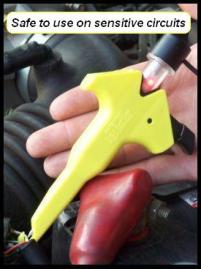|
More about Circuit Buddy |
|
|
|
|
|
From Circuit Buddy's design award to customer testimonials
provides proof of the unique design and durability of Circuit Buddy.
Due to the unique design and the benefit to the user, Circuit Buddy received a design excellence award from the South African Bureau of Standards (SABS).

Please visit our testimonials page to see what our existing customers say about Circuit Buddy.
|

|
THOSE DIFFICULT SITUATIONS!
Circuit Buddy is the ideal test light or wire piercing probe to use when working in difficult situations like under the dashboard of a vehicle. It is in these conditions where you can hook and pierce wires with a one handed operation and be certain that you make contact every time. In these situations it becomes extremely difficult to back probe and therefore to pierce the wire would be the best option. With back probing in these conditions the probe could also cause a short circuit against any nearby metal parts. By using Circuit Buddy as intended, the hole punctured in the insulation is so small that it would be difficult to locate after the test.
WHAT ABOUT CORROSION?
When working inside of a vehicle there would be no corrosion risk when used as a wire piercing probe. Therefore even the connectors found inside of a vehicle would not be protected against the environmental conditions due to no corrosion risk.
|

You need a
CIRCUIT BUDDY!
|
| Circuit Buddy at Johannesburg International Motor Show (JIMS)
|
Prevent damage to sensitive circuits.
Only use a computer safe
test light
| 
|
|
|
More about automotive test lights, sensitive circuits & wire piercing
| Why NOT to use a "globe type" automotive test light on sensitive circuits?
|
| Automotive test lights / circuit testers have been around for quite some time and although effective to use it could cause damage. The standard test light has a sharp point to pierce into the wire and you normally end up poking your finger and that really hurts. In most cases the test lights operates with a globe that indicates a live circuit. Although there are a variety of test lights available they are not always practical and easy to use especially when piercing wires, and NOT always computer safe. Some test lights could cost you thousands in damages to automotive computers or even deploy airbags. If you take a small 3 Watt globe it will cause a current spike of up to 1000 mA that is way over the limit for sensitive electronic circuits. A proper circuit tester should not draw more than 20 mA to be computer save and any rating bellow 20 mA can only be safer to use on sensitive automotive computers.
Circuit buddy draw less than 20 mA @ 48 Volt and even less when using the test light @ 12 or 24 Volt. The approximate current drawn by circuit buddy are as follows: 1.85 mA @ 6 Volt, 3.7mA @ 12 Volt, 7.4 mA @ 24 Volt and 14.8 mA @ 48 Volt. |

|
|
ABOUT WIRE PIERCING PROBES
Wire piercing that leaves a hole in the insulation could lead to water entry and corrosion that could lead to a failure in the circuit. Wire corrosion need to be considered when working on wiring that is exposed to harsh conditions.
When working inside of a vehicle there would be no water present and therefore no corrosion risk.
To pierce wires should be avoided when working on wires exposed to harsh conditions. In the situation where there is no other alternative, it would be best to make the smallest hole possible when puncturing the insulation. The hole would then have a better chance to seal after the test. When working in harsh conditions it would be recommended to also reseal the hole with self-fusing silicone tape or a brush-on liquid insulating material, which is often called “liquid tape”.
|

Example of
liquid tape
|
| Like Circuit Buddy on Facebook |
|
|
| |

















